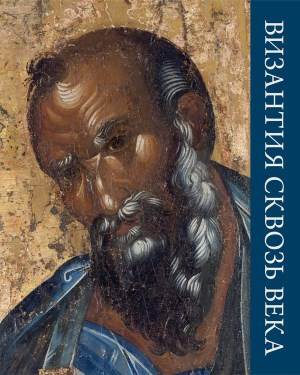 [ каталог выставки ]
[ каталог выставки ]
Византия сквозь века.
/ Каталог выставки.
// СПб: Изд-во Гос. Эрмитажа. 2017. 428 с. ISBN 978-5-93572-718-5
Издание подготовлено по материалам выставки «Византия сквозь века» в Государственном Эрмитаже, 24 июня — 2 октября 2016 г.
Ответственный научный редактор: М.Б. Пиотровский.
Научный редактор издания: Ю.А. Пятницкий.
Автор концепции, подбор экспонатов и куратор выставки: Ю.А. Пятницкий.
См. файл на academia.edu.
[ аннотация: ]
Настоящее издание подготовлено по материалам выставки «Византия сквозь века». Каталог знакомит с произведениями византийского искусства: скульптурой; фрагментами напольных и настенных мозаик; фрагментами фресок, литургическими сосудами; ювелирными изделиями; иллюминированными рукописями, живописными и мозаичными иконами.
Представленные на выставке экспонаты охватывают весь период существования византийской культуры — с первых веков до падения Константинополя в 1453 году.
Для показа в Санкт-Петербурге свои памятники предоставили музеи, библиотеки и монастыри Афин, Фессалоник, Аргоса, Беотии, Верии, Кастории, Коринфа, Лесбоса, Родоса, Серр, Спарты, Хиоса, Фтиотиды и Эвритании, Эвбеи, Элии.
Каталог предназначен для специалистов, коллекционеров и любителей искусства, а также для всех, кто интересуется историей Византийской империи и православной культуры.
Содержание
М.Б. Пиотровский. Эрмитаж — наследник Византии. — 9
А. Балтас. Византия — прославленная греко-римская христианская империя. — 10
М. Андреадаки-Влазаки. Греция и Россия. Две наследницы византийской культуры в совместном современном проекте. — 11
Е. Корка. Великолепие Византии в стенах Эрмитажа. — 12
Ю.А. Пятницкий. Немеркнущая красота блистательной Византии. — 15
Ю.А. Пятницкий. Хранители Византийской коллекции Эрмитажа в 1888-1985 годах. — 23
Карты Византийской империи. — 35
Е. Деллапорта. Византийское искусство IV-XV веков. — 41
Е. Саранти. Византия: великая империя на греко-христианском Востоке. — 55
Ю.А. Пятницкий. Художественный язык византийской иконы. — 73
[ Каталог ]
Памятники византийского искусства.
Собрания Греческой Республики и Государственного Эрмитажа. — 97
Каталожные описания [1-148]. — 325
Список сокращений. — 407
Библиография. — 409
Summary. ^
The Volume is issued in conjunction with the exhibition _Byzantium through the Centuries_ held at the State Hermitage Museum, St Petersburg, Russia, from June 24 through October 2, 2016. The exhibition was organized by the State Hermitage Museum and the Hellenic Ministry of Culture and Sports.
Byzantium was one of the Great Empires which dominated politics, trade and culture in the Mediterranean for over ten centuries. Created after the Roman Empire split in two in 395 to form the Western and Eastern Empires, Byzantium combined the splendour of ancient Oriental cultures, the Roman logic and practicality, the Hellenistic sophistication and elegance and the classic beauty of Ancient Greece. The capital of a new world power was Constantinople (Tsargrad or “City of the Caesar” in Russian chronicles), built by the Emperor Constantine the Great in 324/330 on the shores of the Bosphorus, at the meeting of Asia and Europe. The city struck contemporaries by its organisation, opulence and splendour and became the stuff of legend which ignited the imagination of the entire medieval world. Byzantium, or the Empire of the Rhomaioi, was a multiethnic society of equal citizens, representatives of a civilised world. The term “Byzantine Commonwealth of Nations” was even coined by historians. An important unifying factor among others was Orthodox Christianity. Byzantine art became famous, with its unparalleled beauty, aesthetics and elegant pictorial language. It is characterised by its organic nature, its sense of proportion and balance, a subtle combination of shapes and colours, artistic effects and high spirituality which is felt even in secular items. Byzantine art is dazzling but can be difficult to approach because it is based on associations and emotions. It is highly conventional, especially in its stable iconography which makes subjects instantly recognisable. This made it possible for masters to concentrate on aesthetic and artistic aspects of their works.
Byzantine art is often associated exclusively with icons and church utensils. It is true that Orthodox Christianity had a leading role in the art of the Eastern Roman Empire, but it was not an ascetic, monastic or fanatically religious state. The Byzantines loved life and knew how to live: women were adorning themselves with ornaments; men enjoyed their banquets, hunting, the moral freedom afforded by military campaigns; courtiers were embroiled in plotting or rivalry, comparing their luxurious villas, splendid garments or procured “favours”; the vain ones decorated their houses with their own portraits and busts; the intellectuals explored the depths of sophistry, rhetoric and logic, wrote “histories and chronographies” with varying degrees of faithfulness to facts; deplored the decline of mores and wove tangled schemes with a sophisticated cynicism. The Byzantines, including their Emperors, knew how to sin and repent, cry and laugh, love and hate. But their life unfurled against a magnificent backdrop of Mediterranean landscapes and a comparable man-made splendour of their palaces, temples, mosaics, frescos, icons; silver and bronze utensils; fabrics and curtains embroidered in coloured silks, gold and silver; stunning jewellery, and many other things. To show this beauty, to give visitors a chance to admire the “fragments” of a once great civilisation, to entertain the eye and engage the spirit — these have been our goals in putting together this exhibition, which contains objects of unique artistic value from the museums of Greece and the State Hermitage.
|